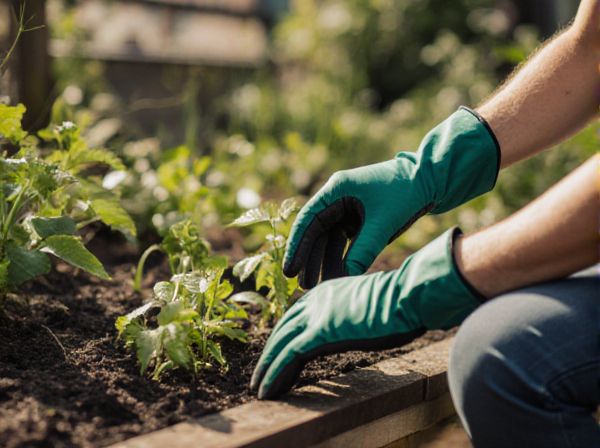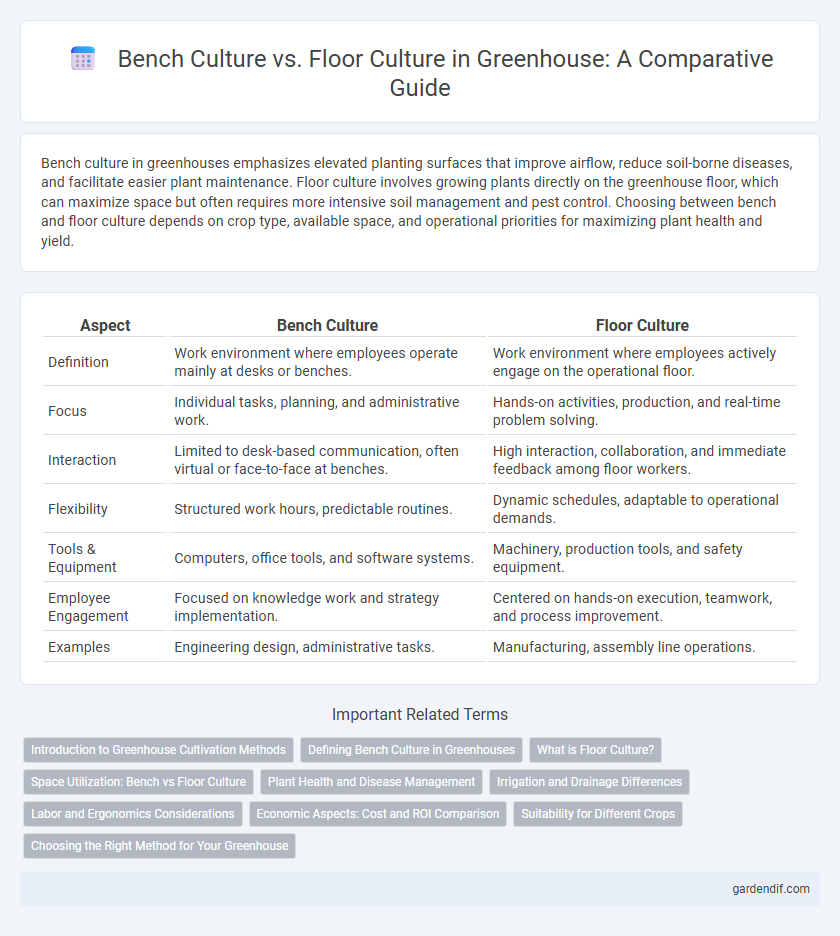
Bench culture vs Floor culture Illustration
Bench culture in greenhouses emphasizes elevated planting surfaces that improve airflow, reduce soil-borne diseases, and facilitate easier plant maintenance. Floor culture involves growing plants directly on the greenhouse floor, which can maximize space but often requires more intensive soil management and pest control. Choosing between bench and floor culture depends on crop type, available space, and operational priorities for maximizing plant health and yield.
Table of Comparison
| Aspect | Bench Culture | Floor Culture |
|---|---|---|
| Definition | Work environment where employees operate mainly at desks or benches. | Work environment where employees actively engage on the operational floor. |
| Focus | Individual tasks, planning, and administrative work. | Hands-on activities, production, and real-time problem solving. |
| Interaction | Limited to desk-based communication, often virtual or face-to-face at benches. | High interaction, collaboration, and immediate feedback among floor workers. |
| Flexibility | Structured work hours, predictable routines. | Dynamic schedules, adaptable to operational demands. |
| Tools & Equipment | Computers, office tools, and software systems. | Machinery, production tools, and safety equipment. |
| Employee Engagement | Focused on knowledge work and strategy implementation. | Centered on hands-on execution, teamwork, and process improvement. |
| Examples | Engineering design, administrative tasks. | Manufacturing, assembly line operations. |
Introduction to Greenhouse Cultivation Methods
Bench culture in greenhouse cultivation involves growing plants on elevated tables, which enhances air circulation, optimizes space utilization, and facilitates pest management. Floor culture refers to plants grown directly on the ground inside the greenhouse, promoting better root development and natural soil interactions but requiring more space and careful moisture control. Understanding these methods helps growers select the best system for specific crops, greenhouse designs, and environmental conditions.
Defining Bench Culture in Greenhouses
Bench culture in greenhouses refers to the method of growing plants on raised benches rather than directly on the greenhouse floor, optimizing space utilization and improving air circulation. This approach enhances plant health by reducing soil-borne diseases and allows for easier maintenance and irrigation management. By elevating plants, bench culture also facilitates better light exposure and efficient use of greenhouse environmental controls.
What is Floor Culture?
Floor culture in a greenhouse refers to the cultivation of plants directly in the ground or designated soil beds, promoting natural root growth and enhanced nutrient absorption. This method supports larger-scale planting, improved air circulation, and efficient use of space compared to bench culture. Floor culture is ideal for crops requiring extensive root systems and consistent moisture levels, contributing to healthier plant development.
Space Utilization: Bench vs Floor Culture
Bench culture maximizes individual workstations, leading to underutilized spaces during employee absences or remote work, often resulting in inefficiencies. Floor culture embraces open-plan environments that optimize collaborative areas and shared resources, significantly enhancing overall space utilization rates. Studies show that organizations adopting floor culture can increase space efficiency by up to 25%, reducing real estate costs and fostering team interaction.
Plant Health and Disease Management
Bench culture involves growing plants in controlled environments on benches, enabling precise monitoring of plant health and early detection of diseases through consistent microclimate management. Floor culture, where plants are grown directly on the greenhouse floor, often experiences higher disease pressure due to variable soil conditions and limited airflow, increasing the risk of soil-borne pathogens. Implementing strict sanitation protocols and integrated pest management in both systems is critical for effective disease prevention and maintaining optimal plant health.
Irrigation and Drainage Differences
Bench culture in greenhouses involves growing plants on raised benches, allowing for precise irrigation management through targeted drip systems that minimize water waste and improve drainage efficiency. Floor culture, where plants are grown directly on the greenhouse floor, relies heavily on surface or overhead irrigation methods that can lead to uneven water distribution and increased risk of waterlogging due to limited drainage control. Optimizing irrigation and drainage in bench culture enhances root aeration and nutrient uptake, promoting healthier plant growth compared to the more variable conditions found in floor culture systems.
Labor and Ergonomics Considerations
Bench culture emphasizes individual workstations where labor tasks are highly segmented, allowing precise ergonomic adjustments to reduce repetitive strain and improve posture. Floor culture encourages collaborative, open workspaces that demand dynamic movement and flexible ergonomic solutions to accommodate diverse tasks. Balancing labor efficiency and ergonomic health requires tailoring workspace design to the specific workflow characteristics of either bench or floor culture.
Economic Aspects: Cost and ROI Comparison
Bench culture often incurs higher operational costs due to underutilized resources and increased downtime, reducing overall return on investment (ROI). Floor culture maximizes workforce engagement and productivity, optimizing resource allocation and delivering a stronger economic performance. Companies adopting floor culture typically experience lower labor costs per output unit and faster ROI cycles, enhancing financial efficiency in greenhouse operations.
Suitability for Different Crops
Bench culture is ideal for delicate crops like seedlings and herbs that require controlled environments and precise management, promoting healthier growth through better air circulation and ease of maintenance. Floor culture suits robust, larger crops such as tomatoes and cucumbers, offering more space and supporting heavier yields with efficient nutrient delivery systems. Choosing between bench and floor culture depends on crop type, growth stage, and spatial requirements, optimizing overall productivity in greenhouse farming.
Choosing the Right Method for Your Greenhouse
Bench culture in greenhouses offers precise control over soil composition and moisture levels, ideal for high-value crops requiring uniform growth conditions. Floor culture provides a cost-effective solution suitable for large-scale production and crops tolerant to variable environments, leveraging natural soil and better drainage. Selecting the right method depends on crop type, budget constraints, and desired yield quality to optimize plant health and resource use.
Bench culture vs Floor culture Infographic

 gardendif.com
gardendif.com